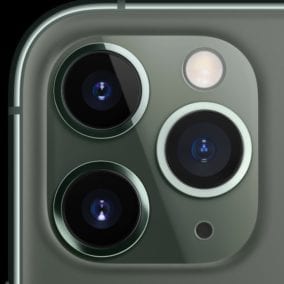
Many iPhone owners use their smartphone as their only camera thanks to the ease of use of the Camera app and the overall quality of the photos. Apple’s latest “Pro” iPhones – the iPhone 11 Pro and iPhone 11 Pro Max – take smartphone-based digital photography to a new level. If you haven’t upgraded to a new iPhone for a few years, the new photo capabilities of the iPhone 11 Pro models make it worth considering an upgrade. use of the Camera app and the overall quality of the photos. Apple’s latest “Pro” iPhones – the iPhone 11 Pro and iPhone 11 Pro Max – take smartphone-based digital photography to a new level. If you haven’t upgraded to a new iPhone for a few years, the new photo capabilities of the iPhone 11 Pro models make it worth considering an upgrade.
Three Cameras
The iPhone’s camera has evolved steadily since the first device shipped in 2007. The original iPhone had a 2MP (megapixel) fixed-focus camera that took pictures that were better than most of the camera-equipped phones of that era, and each succeeding generation has added new features in the form of either new hardware or improved photography software.
While the resolution of iPhone camera sensors has remained fixed at 12MP since the iPhone 6S shipped in late 2015, the sensors have become better and faster (capable of recording 4K video), and Apple has mounted multiple cameras on the back of many of the phone models. The iPhone 11 Pro series is the first to boast three cameras – a Wide (wide-angle, the default camera), a 2X Telephoto, and (for the first time) an Ultra-Wide camera.
Those cameras are apparent on the new iPhones as a triangular cluster in a square camera “bump” on the back of the devices (see image at top of this article). The front-facing selfie camera has also been upgraded. While it was previously a 5MP camera, it’s now at 12MP and capable of shooting 4K selfie videos. Better yet, those 4K selfie videos can be shot at 120 frames per second for a dramatic effect. Apple calls those “slofies”, and is trying to trademark that term.
So what do all of these cameras mean to the average iPhone photographer? Probably the most useful addition is the ultra-wide-angle camera (13mm focal length, f/2.4 aperture, 5-element lens, 120° field of view) that captures up to four times more of a scene than the traditional wide-angle camera. It’s perfect for landscapes, offering a super

One of my pet peeves has been the explosion in “accessory lenses” for the iPhone. While these lenses are designed to provide a wider angle view, act as a macro lens for taking extreme closeups, or provide additional telephoto capabilities to an iPhone, they all – regardless of whether they’re $10 plastic clip
I’ve tested dozens of accessory lenses over the years, and I don’t recommend them for anyone thinking about doing serious photography with an iPhone. The edge distortion and focus issues cause the edges of photos taken with these lenses to be fuzzy and somewhat color-shifted, and the vignetting makes the corner of the images dark and shadowy. In other words, they’re worthless for serious photography.
Those issues are nonexistent with the cameras of the iPhone 11 Pro series. Images shot with all three cameras are bright and undistorted from edge to edge, and the 4X optical zoom range means iPhone photographers can take a variety of high-quality photos and videos without the need to physically change lenses.
One more thing: the telephoto camera now captures about 40% more light, meaning that zoomed photos can be taken at a faster shutter speed with less shake.

Jumping between all of these different cameras is much easier than you’d expect. Fire up the Camera app and you’ll see three buttons – .5, 1X and 2 – indicating ultra-wide, wide, and telephoto cameras (see image above). A tap on any one of those buttons switches to the appropriate camera.

For more fine control, tap and hold on those buttons and a zoom dial appears (see image above). Dragging the zoom dial back and forth produces a smooth transition between the cameras and displays the digital zoom levels. You’ll also note that it shows the lens focal length (13, 26 and 52mm) in gray letters below the zoom level.
Night Mode
While iPhones have always been good at taking photos in many lighting conditions, they’ve always lacked the ability to take decent shots in low light. That all changes with Night Mode on the new iPhone 11 Pro.
The camera sensor on the wide camera is much-improved on the iPhone 11 Pro. For one thing, it offers 100% Focus Pixels (AKA “Phase Detection Autofocus Points”). To avoid getting too technical, let’s just say that this means that drastically improves the ability of the camera to accurately focus – even in low-light conditions.
The wide camera also provides a fast f/1.8 aperture, helpful in gathering as much light as possible. But Night Mode wouldn’t be possible without the advances Apple has made in computational photography – using artificial intelligence algorithms and the ultra-powerful A13 Bionic processor.
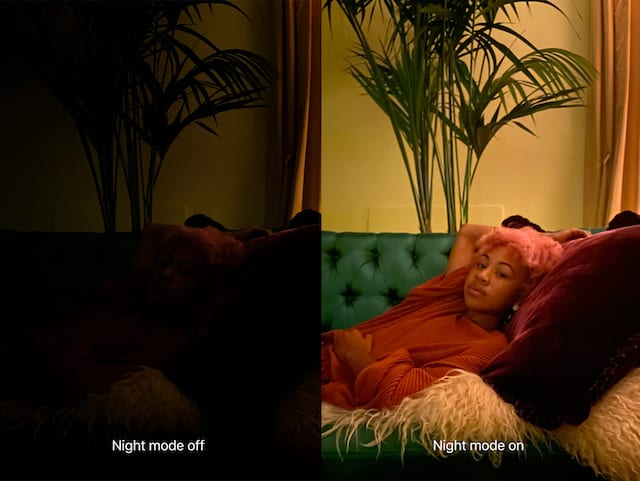
When you are faced with a low-light situation, Night Mode takes over automatically (see image above). You’ll know it’s working when you see a special icon appear that displays the length of the exposure the camera will take. Tapping the shutter button then takes multiple images and uses optical image stabilization built into the wide camera to avoid any blur from slight movements. You’ll still need to be aware that any low-light photography requires a steady hand and no drastic movements.
Once the photo has been taken, the iPhone takes the multiple exposures and aligns them. If there are any images with unacceptable blur, they’re discarded while the sharper ones are “stacked”. Colors are tuned to look natural for the lighting conditions, contrast is adjusted to make sure that the image isn’t either too “foggy” or artificially sharp. The algorithms then remove noise (random pixelation visible in most digital photos taken in darkness) and enhance details.
Coming Soon: Deep Fusion
As soon as iOS 13.2 is out of beta and in the hands of everyone, iPhone 11 owners (even for the non-Pro model) gain the benefit of a new Apple technology called Deep Fusion. Think of it as a very intelligent form of high dynamic range (HDR) photography.
Right now, you can use Smart HDR on most iPhones and iPads to take three images in quick succession. Those images are then analyzed and “stacked” to produce a photo that shows details in both bright and shadowed areas.
Deep Fusion goes well beyond Smart HDR. In most cases, you won’t even know when it is working until you look at your photos. When you’re using the wide camera, Deep Fusion will begin working at just above the 10 lux light level that engages Night Mode. Depending on the light source for your scene, either Deep Fusion or Night Mode will kick in.
With the telephoto camera, Deep Fusion is going to pretty much be the standard computational photography method being used to process your photos unless you’re in extremely bright conditions.
So, what does Deep Fusion do? It starts by capturing an image at a negative EV (exposure value), meaning that the image is quite dark. Deep Fusion uses that image for one purpose: making the image sharper. Next, it shoots three EV0 images, then an EV+ image (a longer exposure for a brighter image).
These final four images are aligned automatically, then blended together into one 12MP image. Next, this image and the negative EV image are run through four separate neural networks that take into account the known noise characteristics of the camera sensors, and “look” at the photo subject matter.
Through the magic of machine learning, each and every pixel in those two images is given full attention for the best possible final image, taking up to a second to process and combine them into a 24MP photo. Although I haven’t yet had the opportunity to try Deep Fusion, the test images that are being posted on the Internet show that it does an incredibly good job, with little or no post-processing of the images required.
Capture Outside the Frame
Oddly, Deep Fusion doesn’t work when another iPhone 11 Pro feature is enabled – Capture Outside the Frame. This setting makes it possible to capture content (photos and videos) that is outside of the frame seen in the Camera viewfinder.
Set up in Settings > Camera > Composition, Capture Outside the Frame requires that you use Apple’s HEIC and HEVC image and video formats rather than JPG and MP4. Note that your iPhone 11 Pro can auto apply adjustments to the extra data it captures, in essence cropping and moving the image to produce the best possible composition.
This can take a little time to do, so it’s best to let the images or videos sit in the Photos app for a bit. If you don’t like the result, you can edit the image in Photos – any image or video with data outside of the frame will show a rangefinder icon with a small star in it. Tap Edit, then tap the Crop button and finally pinch in on the image to zoom out to as much of the super-wide view as you want.
Automatic Switch Between Close and Wide-Angle Selfies
Are you a selfie fan? The iPhone 11 camera now offers both manual and automatic ways to switch between close selfies – where your head fills most of the frame – and wide-angle selfies that might include friends.
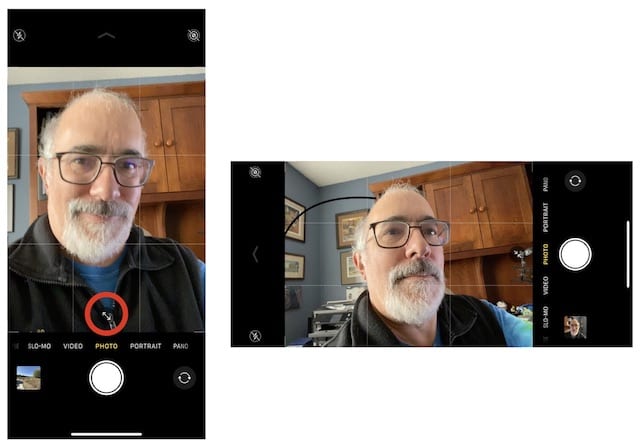
Once you’ve set your iPhone Camera app to capture a selfie with the front-facing camera, you’ll see an arrows button (two white arrows pointing in opposite angled directions, circled in red in the illustration above). Tap that to manually switch between close and wide-angle views of your lovely face, or simply rotate the iPhone to one side to automatically switch to a wide-angle view.






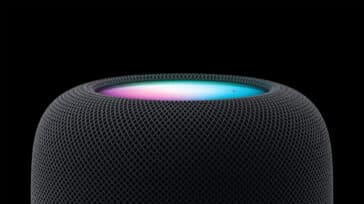
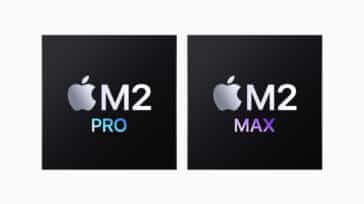


Apple is finally catching up the the camera design in 2012 on the Nokia PureView 808. ‘Bout time!
Apple has spent so much effort renaming existing technology and claiming it as their own “new” inventions. They could do a lot more by doing their own R&D instead of copying and renaming.
Did Apple invent Airplane Mode? No, only the name for an existing technology: OFFLINE.
Did Apple invent FaceTime? No, it simply renamed an existing technology: VIDEO CALLS [and it didn’t even work on a phone network!]
I used to work for Apple. I use a Mac for most of my work. I wish they could be more careful and honest about their own inventions. Copies of competing technologies are just that – copies. Apple can/should do better.
The handiness and versatility of the iPhones make “real” cameras a burden to carry and of limited usefulness to most people other than dedicated photographers.
I should know, I own five Laicas, three of each Nikons, Sonys, and Lumix, plus a host of others–yet, they stay home.
I believe that as the iPhone cameras become better and more versatile, there may be a time when you would question the value of purchasing a “real” camera.
Saludos,
Rolando
I will upgrade when Apple’s $1,000 phones start working in areas where $350 LGs do, but my X Max doesn’t.
It seems to me unclear if you can use these 3 different lenses (or cameras) also for video, I tried an iPhone Pro in a shop and it only used just one lens(camera)
I know this because I held my fingers before the other lenses.
I can ‘t find find any info about this topic so far,…
Anyone who knows more about this?